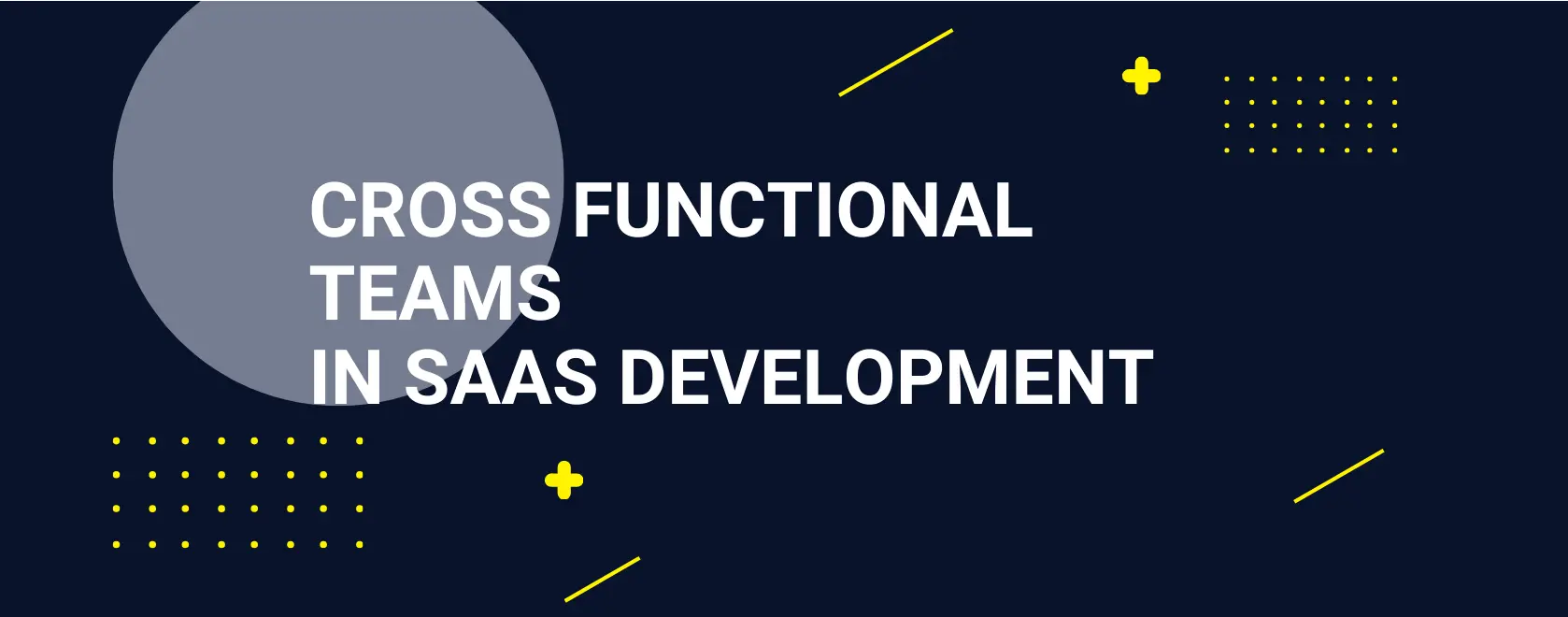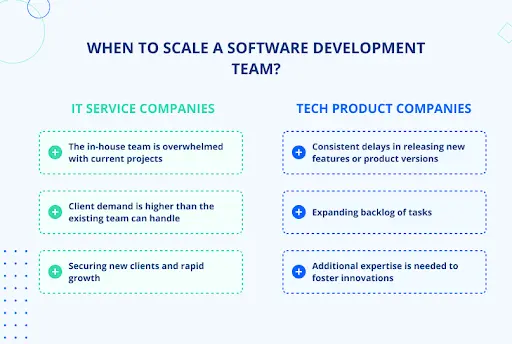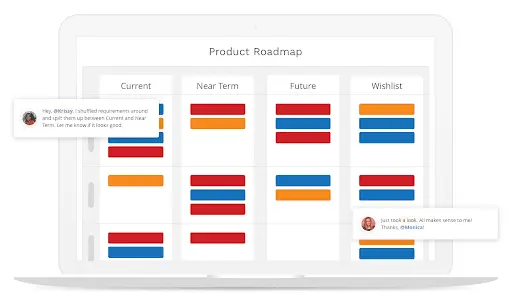- Product development
- 19 Feb 2024
Build a cross-functional team for your SaaS development journey. How to do it and most common mistakes
SaaS product development team



Table of contents
- Introduction
- Understanding cross-functional teams and SaaS team structures
- Building the team for different development stages
- Scaling your development team: when and how to start
- The most common challenges about scaling your development team
- Product management tools
- Common mistakes in scaling the SaaS development team
Contributors

Cross functional collaboration meaning
When a SaaS company delivers exceptional products, user engagement follows—and customer satisfaction grows. This comprehensive guide on digital product management reveals proven strategies from leading SaaS teams, helping you scale your product ideas with success.
When a SaaS company delivers exceptional products, user engagement follows—and customer satisfaction grows. This comprehensive guide on digital product management reveals proven strategies from leading cross-functional teams in successful SaaS companies, helping you scale your product ideas with success.
Consider this scenario: A highly skilled, cross-functional team of engineers, designers, and business strategists working seamlessly together to bring your SaaS product to life. Each role plays a critical part in the process, from the engineers developing robust code to the product owner steering the overall vision and ensuring alignment with business objectives.
If you’re looking to dive deeper into SaaS development and the phases of the Software Development Life Cycle (SDLC), it’s important to recognize that this is a vast area requiring detailed study. This guide offers an introduction to these essential elements, but mastering them is key to building scalable, successful SaaS solutions.
If you’re looking to dive deeper into SaaS development and the phases of the Software Development Life Cycle (SDLC), it’s important to recognize that this is a vast area requiring detailed study. This guide offers an introduction to these essential elements, but mastering them is key to building scalable, successful SaaS solutions.
Understanding cross-functional teams and SaaS team structures
Product Owner and Development Team
Meet the one who guides the whole process, your product owner. He crafts the product’s vision, manages its life cycle, and bridges the gap between the development team and business goals. And speaking of the team, say hello to your UX/UI designers and software engineers—the duo ensuring your product’s aesthetics and functionality. They collaborate with the technical product manager to bring your idea to life.
Quality Assurance, DevOps, and Customer Support/Success
Let’s talk about the quality of software as a service. Your QA team hunts bugs to ensure top-notch standards, while DevOps handles automation and deployment for smoother operations. And your Customer Support/Success team? They assist users, gather feedback, and keep clients engaged with your business.
Sales and Product Marketing Managers, Data Analysts, and Beyond
Allow the experts in sales and marketing to take over, helping to position your product in the market, generate leads, and spread the word about your SaaS solution.
Your product marketing manager is ready! Data analysts study information for growth insights. Behind the scenes, your Scrum Master/Agile Coach, Security Experts, and Legal/Compliance team ensure safety, security, and compliance.
Collaborate with cross functional teams for different development stages
Starting SaaS development involves more than just assembling a team—it’s about building cross-functional teams that adapt and evolve through each phase of your product’s lifecycle. From concept to growth, strategic team-building is essential to your SaaS product’s success. Whether you’re in the early stages or scaling rapidly, your cross-functional team will grow, adjust, and ultimately drive your business forward.
Let’s explore the key stages of team building in project management for software development:
Inception Stage:
At the beginning, focus on forming a flexible and agile cross-functional team. Your key players include a visionary Product Manager, a versatile Developer, and a UX/UI Designer. This dynamic trio lays the foundation, translating your original idea into a clear, well-defined product.
Development Stage:
As your product gains traction, expand your team. Bring in Quality Assurance (QA) specialists to ensure flawless functionality, and enlist a DevOps expert to streamline operations. At this stage, your cross-functional team refines the product and prepares it for launch, ensuring smooth delivery.
Launch and Growth Stage:
The big moment arrives. To maintain high levels of customer satisfaction, include a Customer Support/Success team in your software development process. This is also the time to strengthen your marketing and sales efforts, generating buzz and driving adoption in the marketplace.
Scaling Stage:
As your SaaS business scales, add Data Analysts to your cross-functional team to gain insights that drive continuous improvement. Ensure scalable infrastructure, security, and compliance with industry standards by incorporating Scrum Masters, security specialists, and Legal/Compliance experts.
Adjusting your digital product management team as needed is crucial for success in the complex world of SaaS. By building agile, cross-functional teams, you’ll be well-equipped to navigate each stage of your product’s lifecycle effectively.
Effective cross functional teams in software development: when and how to start
Deciding when to grow your development team is vital. This guide provides insights into the best timing and steps to start scaling, along with recommended product management tools.
 Source: https://jaydevs.com/how-to-scale-a-software-development-team/
Source: https://jaydevs.com/how-to-scale-a-software-development-team/
Evaluate the Workload of Your Cross-Functional Team
Begin by assessing your team’s current responsibilities. If they are consistently under pressure to meet deadlines, it may be time to implement project management software on a larger scale to streamline processes and improve efficiency.
Assess Project Complexity
Consider the complexity of your upcoming projects. If they require specialized skills beyond your cross-functional team’s expertise, this could indicate the need for expansion or additional resources.
Monitor Efficiency and Productivity
Observe how your cross-functional team operates. If you notice slowdowns, delays, or quality issues, it may signal that your team size is limiting productivity. In such cases, the product manager plays a vital role in identifying bottlenecks and addressing inefficiencies.
Analyze Market Opportunities
Stay informed about market trends. If you see a rise in user interest or growth potential, expanding your team with a product marketing manager can help capitalize on these opportunities and drive further growth.
Plan Ahead for Team Expansion
Scaling a cross-functional team isn’t just about increasing numbers; it’s about thoughtful, strategic planning. Define the specific roles you need, anticipate skill requirements, and create a clear roadmap for expansion to align with your product development goals.
Embrace Flexibility in Team Structure
Be flexible in your approach to team building. Consider using freelancers, contractors, or part-time contributors to complement your core cross-functional team initially. This allows you to gauge their impact before committing to permanent hires.
Foster a Collaborative Culture
As you scale your cross-functional team, ensure that new members integrate smoothly with the existing team. Promoting a collaborative culture is key to maintaining a positive, productive environment that drives project success.
Leverage Technology for Better Team Coordination
Utilize collaboration tools and project management software to streamline workflows and enhance communication. As your cross-functional team grows, these technologies become essential for maintaining coordination, especially with the support of a technical product manager.
Continuously Evaluate Team Performance
Regularly evaluate the effectiveness of your scaled cross-functional team. Gather feedback from team members, monitor project outcomes, and be ready to adjust your approach as needed for optimal results.
Prioritize Team Morale
As you expand your cross-functional team, prioritize morale. Rapid growth can create challenges, so it’s important to ensure that your team feels valued, supported, and connected to maintain long-term success.
Conclusion: Strategic Team Expansion
Expanding your cross-functional team requires thoughtful planning. By understanding current needs, future goals, and team dynamics, you can scale effectively. With flexibility and a focus on product lifecycle management, your team will be ready to succeed as your projects grow.
The most common challenges about scaling your cross-functional team of developers
Starting to scale your team is great, but it comes with challenges in product lifecycle management. Together, let’s face the main obstacles and tactics.
- Finding and keeping talent
Hiring and keeping skilled developers is tough in today’s market. Offering competitive pay and a positive work environment are key to attracting and retaining top talent.
- Communication breakdowns
As teams expand, effective communication becomes trickier. Transparent channels and product management tools are important to prevent misunderstandings and delays.
- Cultural alignment
Integrating new team members can disrupt the group dynamic. Proactive measures, team-building events, and thorough onboarding help maintain a united culture.
- Project management complexity
Scaling adds complexity to project management. Using agile methods and clear project guidelines simplifies workflows and reduces complications.
- Balancing speed and quality
Balancing speed and quality is key. With careful planning, ongoing evaluation, and sustainable practices, you can achieve fast growth without sacrificing quality.
- Resource allocation
Properly allocating resources becomes a puzzle as the team expands. Regular assessments and flexibility in allocation strategies are key to overcoming this obstacle.
Scaling your development team involves navigating these challenges and following great product lifecycle management. Do you want to know more about it? Well, you can see what BEECODED developers have to say in this article.
Product management tools for cross-functional teams
To handle project management software well, you need the right tools. Here are a few examples: Jira offers customizable workflows and detailed reports.
Trello organizes tasks visually with boards, lists, and cards. Asana, a flexible project management software tool, excels at task assignments, due dates, and progress tracking, keeping teams organized and on track.
 Source: https://www.productplan.com/learn/product-management-tools/
Source: https://www.productplan.com/learn/product-management-tools/
Monday.com can be used for project and team management, Productboard for product managers, Confluence for collaboration, Slack for real-time communication, and Airtable for flexible data management. Choosing the right tools can improve your product management, making delivery more efficient.
ClickUp, one of the top 10 project management tools, is a very flexible platform with which our company works well together.
By using ClickUp’s agility, we can customize our tasks and processes to match the changing requirements of our projects. Because of ClickUp’s dynamic capacity, we can prioritize, plan, and complete activities, which results in a more efficient and successful project management process.
Common mistakes in scaling your cross-functional team
Expanding your SaaS cross-functional team is a big move, but it can be tricky. In this guide on project management software, we’ll help you avoid common mistakes and ensure a smooth journey for your team.
1. Rushed hiring decisions
A big mistake is rushing hires. Choosing the wrong people fast can disrupt teamwork and productivity. Prioritize quality over speed to build a team that fits your vision, especially in product lifecycle management.
2. Ignoring team communication
Team growth can lead to communication breakdowns. Clear channels prevent misunderstandings and delays. Maintain transparent communication to avoid issues. Use one of the top 10 project management tools for better communication!
3. Overlooking cultural alignment
Growing fast can make teamwork harder. Make sure new people fit your company’s values. A good product owner and product manager help everyone get on the same page.
4. Ignoring scalability in processes
Scaling without improving processes can cause chaos. Adapting workflows, methods, and tools for a bigger team prevents inefficiencies and keeps projects moving.
5. Lack of leadership and structure
Scaling needs clear leadership and structure. Without it, roles can overlap and teamwork suffers. Strong leadership, including a product manager, is crucial for success.
6. Failure to prioritize employee development
When scaling fast, companies may forget to develop their team. Without ongoing training, growth stalls and the team becomes less adaptable.
7. Ignoring employee morale
Ignoring employee morale hurts. Fast growth can stress your team, leading to burnout and less satisfaction. Prioritize a positive environment and support to keep morale high, with user-friendly project management software.
By steering clear of these common mistakes, you set the stage for a successful and sustainable scaling journey for your SaaS development team.
10 NLP examples you use every day without realizing
12 Natural Language Processing techniques used to process text by data scientists
What is natural language generation? (NLG)